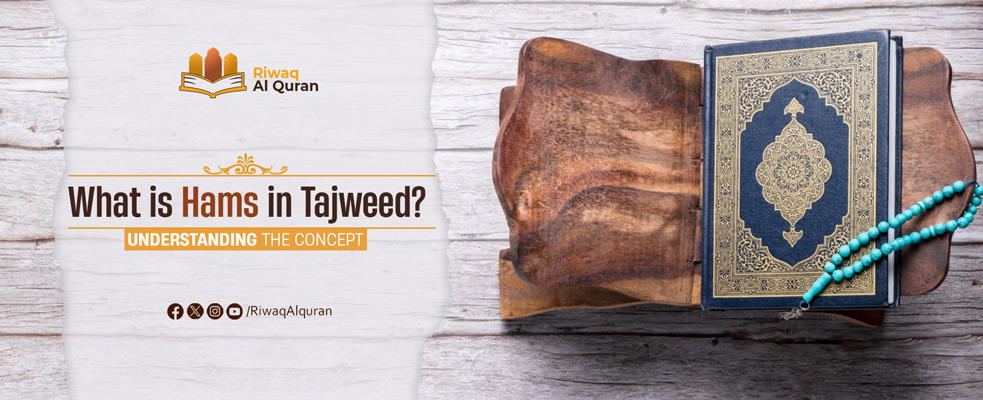Tajweed is to learn how to properly recite the Qur’an by learning how to perfectly pronounce each Qur’anic, Arabic letter with its certain articulation-point (makhraj), and apply its unique characteristics (siffat Al-Huruf).
The Qur’anic letters have various characteristics that distinguish them. Hams is one of those characteristics that distinguishes a group of the Arabic letters. Let’s know more about hams in tajweed, and practice some examples, together.
Table of Contents
What Is Hams
Linguistically, “Hams” is a noun derived from the verb hamsa, meaning (to whisper). In tajweed, hams is one of the letter-characteristics (siffat Al-Huruf) that indicates the concealment of its letters that are associated with slight breathing out, or airflow, accompanying the pronunciation of a group of letters in Arabic that can be originally attributed as light, and weak.
In tajweed, hams is associated with that subtle breathy, whisper-like sound when pronouncing some letters when they are emphatic (with shaddah), and with vowel, yet, more clearly when pronouncing those letters with sukun (with no vowel). Hams is the contrast of Jahr.
The Hams Letters
The hams letters are those who are characterized with that smooth, breathy airflow passing through the mouth. Those letters are gathered in the Arabic statement : فحثه شخص سكت [((Fa) , ح (Ha), ث (Tha), ه (Ha), ش (Sheen), خ (Kha), ص (Saad), س (Seen), ك (Kaaf), ت (Ta))].
Practicing the proper pronunciation of those letters, you can find that ‘hams-characteristic’ weakens the letter as running of breath, then weakens the strict stress on the articulation point:
Hams Examples:
| The Hams Letter | The Example Ayah | Transliteration |
| ف (Fa) | ﴿فِي الْمُنافِقِينَ فِئَتَيْنِ﴾ [النساء:88] | / Fi Al-Munafiqeen Fi’atain/ |
| ح (Ha) | ﴿وَلَتَجِدَنَّهُمْ أَحْرَصَ النَّاسِ عَلَى حَيَاةٍ﴾ [البقرة/96] | / Walatajidannahum ahrasa annasi ‘AAala hayatin/ |
| ث (Tha) | [الفرقان: 13 ]﴿دَعَوْا هُنالِكَ ثُبُوراً…) | / daAAaw hunalika thuboora/ |
| ه (Ha) | )وَيْلٌۭ لِّكُلِّ هُمَزَةٍۢ لُّمَزَةٍ ١) الهمزة: 1[ | / Waylun likulli humazatin lumaza/ |
| ش (Sheen) | (شَهِدَ اللَّهُ أَنَّهُ لَا إِلَٰهَ إِلَّا هُوَ ) [آل عمران: 18] | /Shahida Allahu annahu la ilahailla huwa/ |
| خ (Kha) | ﴿فَإِذَا هُمْ خَامِدُونَ﴾ [يس/29]. | / fa-itha hum khamidoon/ |
| ص (Saad) | ﴿ صُحُفِ إِبْرَاهِيمَ وَمُوسَى ﴾[الأعلى/19] | /Suhufi ibraheema wamoosa/ |
| س (Seen) | ﴿وَسُيِّرَتِ الْجِبَالُ فَكَانَتْ سَرَابًا﴾ [النبأ: 20] | /Wasuyyirati aljibalu fakanat saraba/ |
| ك (Kaaf) | ﴿قُلْ مَنْ يَكْلَؤُكُمْ﴾ [الأنبياء:43]. | /Qul man yaklaokum/ |
| ت (Ta) | ﴿تَبَّتْ يَدَا أَبِي لَهَبٍ وَتَبَّ﴾ [المسد: 1]. | /Tabbat yada abee lahabin watab/ |
Note: It is crucial to learn the precise pronunciation of these letters by the help of an Arabic-native teacher, as there are some letters like ص (Saad), and س (Seen), seem to be transliterated alike /s/, yet in Arabic, there is a subtle, distinguishing difference in their pronunciation.
Read more about: Hafs’ Tajweed Rules
What to Consider When Applying Hams:
To produce that whispery sound of the hams letters, you need not to completely seal the articulation-point of the letter, but just pronounce those letter with a little press, so that it can let out that whisper-like breath flow.
If you don’t let that whispery breath out, while pronouncing, you miss the hams-characteristics, and even mix it up with the contrast “Jahr”; in jahr, we hold back the breath, and stress heavily on the articulation point, resulting in a heavy, apparent sound. That is totally the opposite of hams. Have a look at that simple comparison:
| Hams | Jahr | |
| Linguistic Indication: | It indicates concealment, linguistically. | It indicates manifestation, or something apparent, linguistically. |
| The Application Way: | Running on of breath when pronouncing the letter, with a little stress on the articulation-point, so that it can produce the whispery sound for that letter which is originally light. | Holding back the breath when pronouncing the letter, with a strong stress on the articulation point, so that it can produce the apparent sound for that letter which is originally heavy. |
| The Letters: | [(ف (Fa), ح (Ha), ث (Tha), ه (Ha), ش (Sheen), خ (Kha), ص (Saad), س (Seen), ك (Kaaf), ت (Ta))]. | The rest of the Arabic alphabet. |
Read more about: Tajweed Symbols


Learn Quran, Arabic And Islamic Studies Online With The Best Native Tutors
Riwaq Al Quran is a comprehensive online platform that offers personalized Quran, Arabic and Islamic Studies Online classes for individuals of all ages and backgrounds.
Their experienced instructors use a structured curriculum to cover Tajweed, Tafsir, and Memorization, providing easy and effective access to learning the Quran.
The advanced online classes allow for seamless communication and interaction between students and teachers. Join Riwaq Al Quran for a deeper connection with the Quran.
We offer several courses such as:
- Online courses for kids.
- Online Quran classes for kids and adults.
- Online Arabic courses
- Online Ijazah courses
- Online Islamic Studies courses.
Here are a sample of our set of Quran Courses that will be helpful for you:
- Online Tafseer Course: Delve into Quranic meanings with our insightful online Tafseer course.
- Noorani Qaida Online: Learn Quranic basics efficiently through our Noorani Qaida online program.
- Online Quran Recitation Course: Enhance Quranic recitation skills through our expert-led online course.
- Online Tajweed Classes: Master Tajweed rules for beautiful Quranic recitation in online classes.
- Quran Memorization Online Course: Memorize the Quran effectively with our specialized online memorization course.
- Online Qirat Course: Explore diverse Qirat styles with our comprehensive online Qirat course.
- Online Quran Classes for Kids: Nurture a love for the Quran in kids through interactive online classes.
Conclusion:
Hams, jahr, and others of the letters’ characteristics require a high level of attention, accuracy, and practice with the help of a specialized Arabic-native teacher, like in Riwaq Academy, for mastering pronouncing them right.
Undoubtedly, those subtle nuances highlight the inimitable beauty and perfect rhythm of the Qur’an, preserving its genuine meanings. Whoever gets well-versed at reciting the Qur’an, by applying all of its precise tajweed techniques, he will definitely enjoy its rewarding recitation, thoughtful understanding, and endless blessings.


































